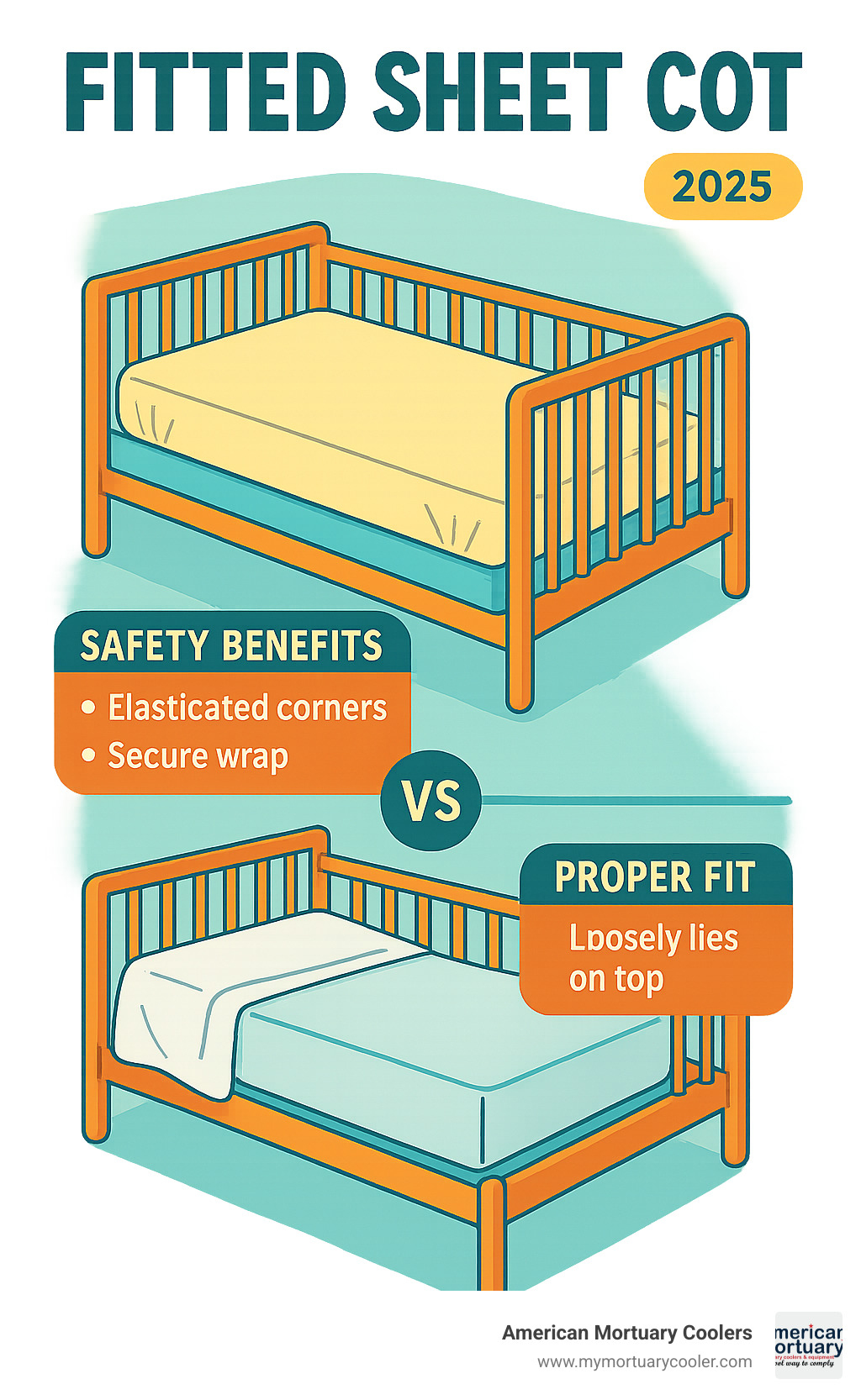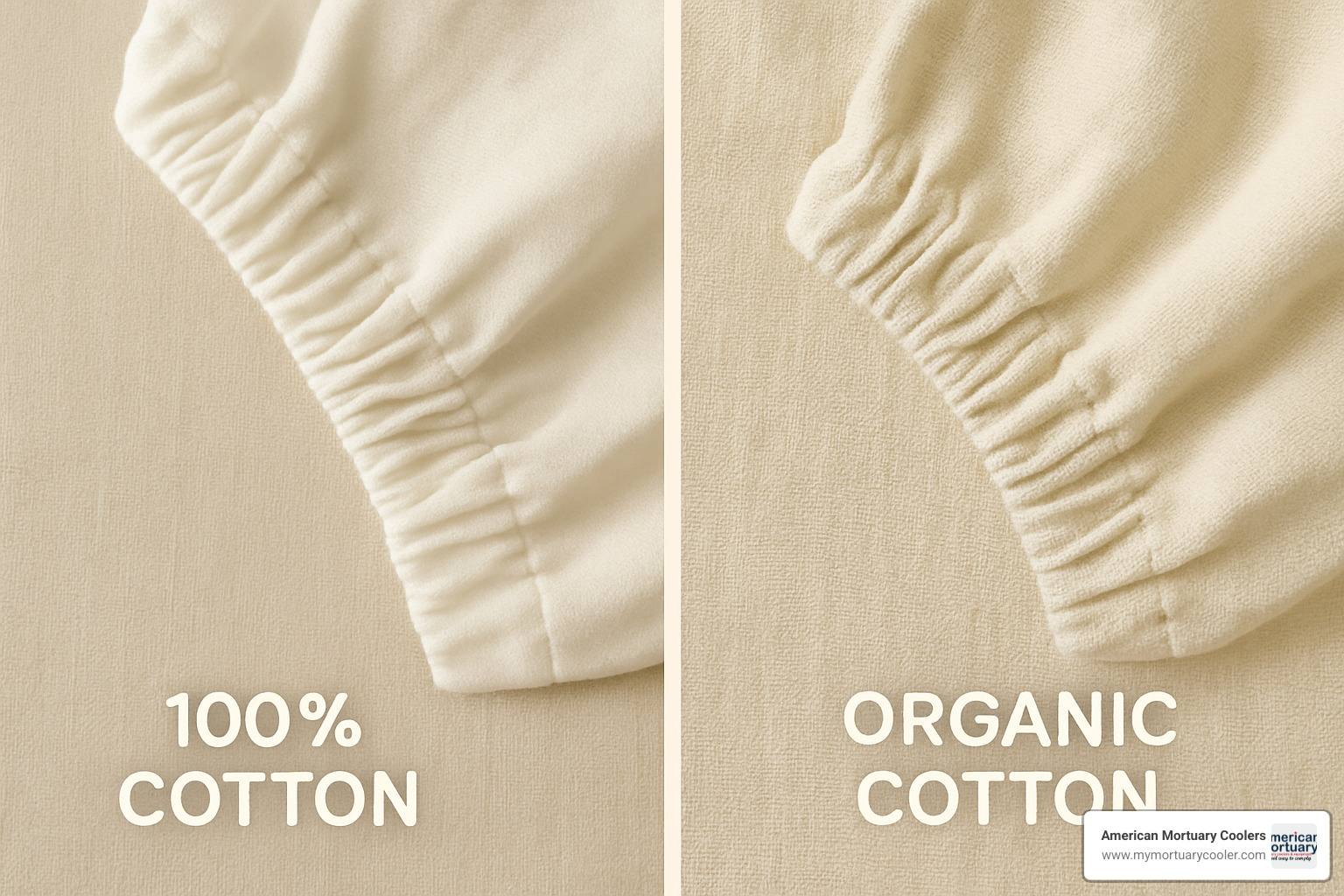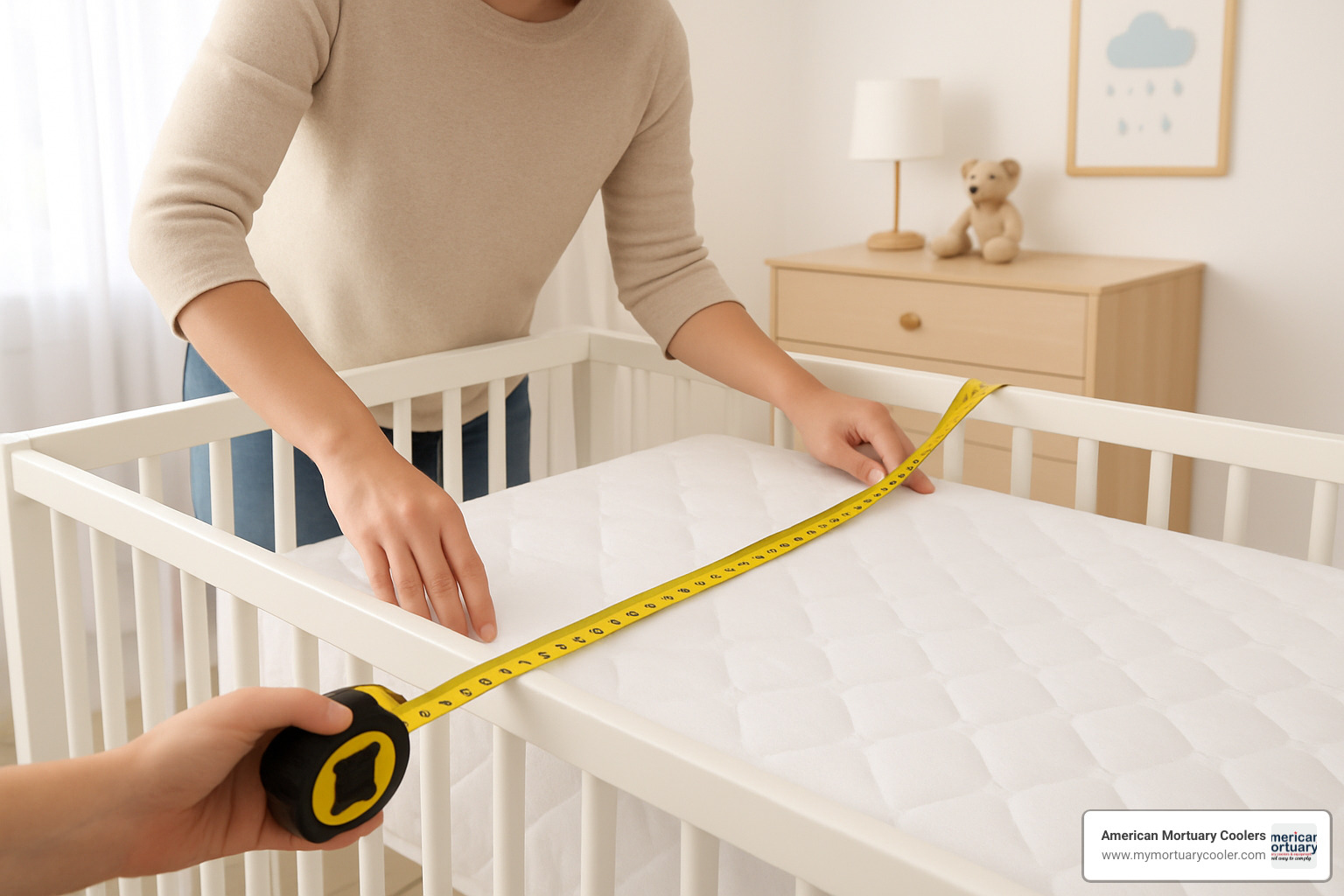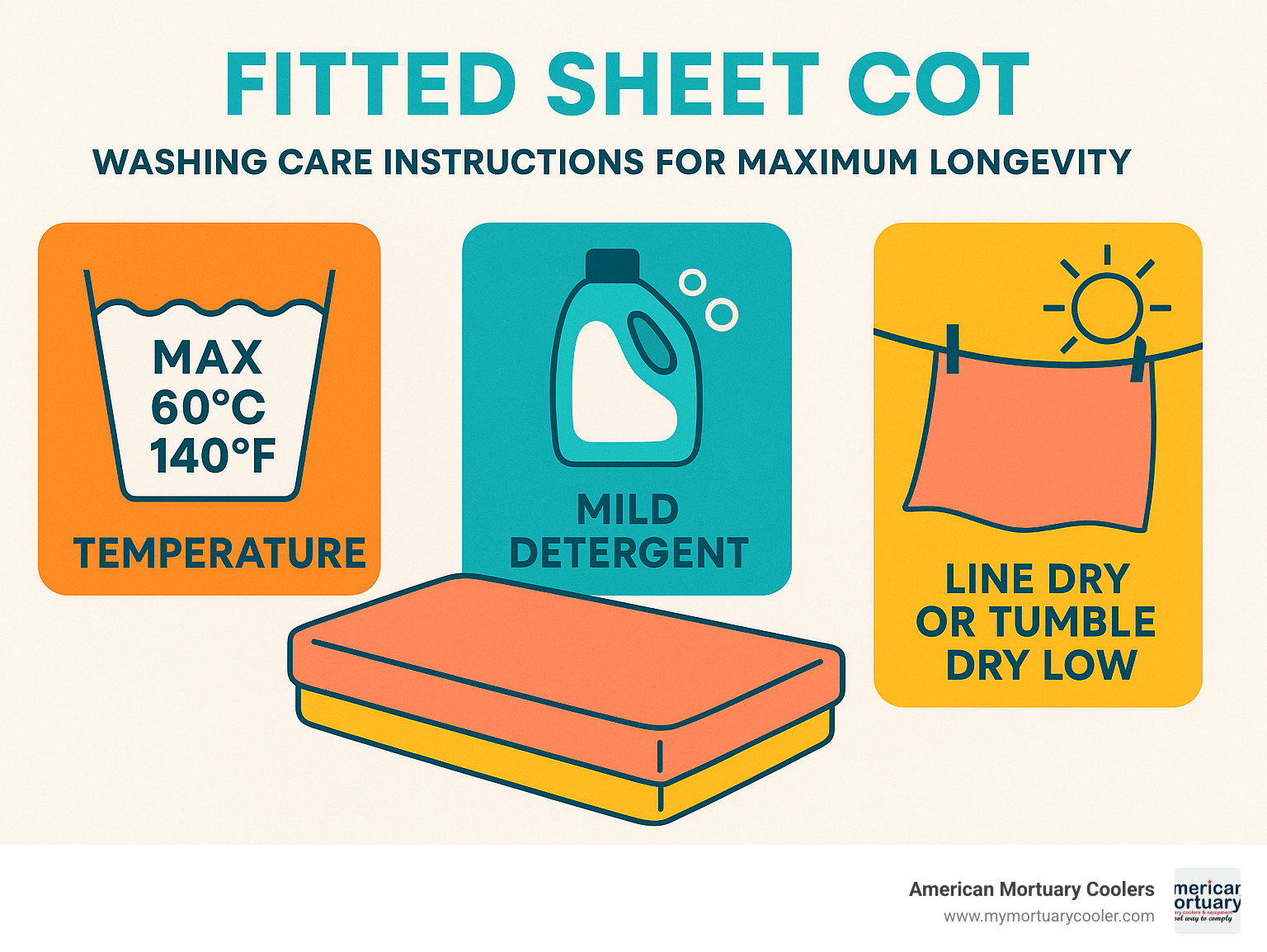Why Choosing the Right Fitted Sheet Matters for Your Cot
A fitted sheet cot is a specially designed sheet with elasticated corners that securely wraps around cot mattresses, providing a safer and more comfortable sleep surface than traditional flat sheets.
Key Features:
- Elasticated corners prevent sheet displacement and reduce mess risks
- Snug fit eliminates loose fabric that could pose safety concerns
- Easy installation with corner pockets that stretch over mattress edges
- Multiple sizes including spacesaver (100×52cm), compact, and full-size options
Common Materials:
- 100% cotton for breathability and softness
- Jersey knit for stretch and comfort
- Organic cotton with GOTS certification
- Waterproof blends for accident protection
When parents search for the right bedding solution, fitted sheet cots offer significant advantages over flat sheets. Cotton is the most popular choice, recommended for its breathability and gentle touch on delicate skin.
These sheets come in various sizes to fit different cot types - from spacesaver cots at 100×52cm to full-size options measuring 30×75 inches. Price ranges vary from £4.99 to $34.99, with multi-packs offering better value.
I'm Mortuary Cooler, a national-level supplier with experience in specialized bedding solutions, including fitted sheet cot applications for various care environments. My background in providing reliable, durable equipment has given me insights into quality bedding that stands up to frequent use and washing.

Fitted sheet cot further reading:
What Is a Fitted Sheet Cot and Why It Matters
A fitted sheet cot is like a custom suit versus an oversized hand-me-down. While flat sheets simply drape over the mattress, fitted sheets come with elasticated corners that hug every edge of your cot mattress, creating a secure, custom fit that stays put all night.
The elastic edges grip the mattress firmly, accommodating various mattress depths without slipping. This isn't just about convenience - it's about creating a safe, comfortable sleep environment that gives both babies and parents peace of mind.
What makes this design better than flat sheet differences? Security and safety focus. When your little one tosses and turns, a fitted sheet stays exactly where you put it. No bunching, no loose fabric, no middle-of-the-night sheet adjustments needed.
For families on the go, the portability factor is huge. Fitted sheets pack smaller, install faster, and eliminate the fussing that comes with trying to tuck flat sheets under awkward cot corners.
Standard Cot Dimensions & Fit Essentials
Getting the right fit starts with knowing your numbers. Here are the most common cot sizes and their fitted sheet requirements:
| Cot Type | Dimensions (cm) | Dimensions (inches) | Mattress Depth | Best For |
|---|---|---|---|---|
| Spacesaver | 100 x 52 | 39 x 20 | Up to 10cm | Small nurseries |
| Compact Crib | 61 x 130 x 5 | 24 x 51 x 2 | 5cm standard | Bedside sleepers |
| Camp Cot | 76 x 191 x 23 | 30 x 75 x 9 | Variable | Travel, camping |
| Full-Size Crib | 71 x 132 | 28 x 52 | Up to 15cm | Standard nursery |
The 100×52 cm spacesaver size is popular with urban families, while the 30×75 inch camp cot dimensions work for weekend getaways. Cotton sheets can shrink up to 5% maximum shrinkage after their first wash, which actually works in your favor - a slightly snugger fit means better security.
Primary Benefits of a Fitted Sheet Cot
The advantages of choosing a fitted sheet cot become obvious the moment you start using one. That wrinkle-free surface means your baby sleeps on a smooth, even surface without pressure points or uncomfortable bunching.
Reduced mess becomes your new reality. When sheets stay put, spills and accidents are contained better. Quick bed-making transforms from a chore into a 30-second task. Temperature regulation improves with consistent contact between sheet and mattress - no air pockets means no hot spots or cold zones.
Materials & Special Features for Comfort and Safety

When choosing the right fitted sheet cot, material makes all the difference. After years of working with specialized bedding solutions, I've seen how the right fabric transforms a nursery experience.
Cotton remains the champion for baby bedding. This natural fiber breathes beautifully, keeping little ones comfortable throughout the night. Cotton also gets softer with every wash.
Jersey knit cotton takes comfort up a notch with its stretchy, t-shirt-like feel. The knit construction makes fitting your fitted sheet cot easier since it naturally gives and moves with the mattress.
Flannel cotton provides extra warmth without sacrificing breathability. The brushed surface creates tiny air pockets that trap warmth while allowing air circulation.
Polyester microfiber offers practical benefits for busy households. It resists wrinkles, dries quickly, and handles stains better than natural fibers.
Waterproof TPU-backed sheets solve the protection versus comfort dilemma. These designs put a thin waterproof layer between the cotton surface and mattress, stopping accidents while keeping the sleeping surface soft and breathable.
Scientific research on breathable fabrics shows that fabric choice directly impacts sleep quality and safety.
Eco-Friendly & Organic Options
More families are choosing organic options for their fitted sheet cot. GOTS certification represents the gold standard in organic textiles, ensuring at least 70% of fibers come from organic sources with strict limits on chemical treatments.
Organic cotton eliminates pesticides and harsh chemicals from the growing process. Low-impact dyes create beautiful colors without heavy metals or toxic substances. Sustainable farming practices extend benefits beyond your nursery, protecting soil health and reducing water usage.
More info about best cot sheets dives deeper into making environmentally conscious choices.
Added Protections and Upgrades
Modern fitted sheet cot designs go beyond basic function. Integrated flat sheet combinations streamline bedding changes in childcare settings. Sleep-mat combos cater to daycare environments with precise 122cm x 56cm x 5cm dimensions.
Waterproof barriers built into fitted sheets provide accident protection without the crinkly plastic feel. Zippered safety sheets completely enclose the mattress with a zipper closure, eliminating any possibility of loose fabric.
Fitted Sheet With Attached Flat Sheet options show how manufacturers are innovating for professional childcare environments.
How to Choose and Properly Fit Your Fitted Sheet Cot

Choosing the perfect fitted sheet cot is like finding the right pair of jeans - size matters, but it's not the whole story. Start with accurate measurements of your mattress, but consider much more for your little one's comfort and safety.
When measuring your mattress, grab a flexible measuring tape and check length, width, and most importantly, depth. Don't rely on manufacturer's stated dimensions - measure at the widest points to get the true size.
Depth allowance is where many parents make mistakes. Your fitted sheet needs to wrap around the full mattress thickness plus have enough fabric to grip securely underneath. If you have a 6-inch thick mattress, look for sheets with pockets that accommodate 8-9 inches.
Elastic quality determines whether your sheet will fit properly after months of washing. Good elastic should feel firm but not overly tight. Look for sheets where elastic runs completely around the perimeter rather than just being sewn into corners.
Thread count affects comfort and durability. For fitted sheet cots, a thread count between 200-400 gives you the sweet spot of softness, breathability, and long-lasting quality.
Step-by-Step Fitting Guide for a Fitted Sheet Cot
Installing your fitted sheet cot properly is easier than you think. Always start by washing your new sheet according to manufacturer's instructions.
Start by finding the orientation - many sheets have tags showing which end goes where. Position the sheet by aligning the tag with the foot of the mattress.
Pull the corners diagonally across the mattress, starting with one corner at a time. Stretch it over the mattress corner and pull it down until the elastic grips firmly. Work around the mattress systematically, fitting each corner in turn.
Smooth the surface once all corners are secure. Run your hands across the entire sheet to eliminate wrinkles or air bubbles.
Safety Considerations With a Fitted Sheet Cot
Safety is everything when it comes to your baby's sleep environment. Once you've fitted your fitted sheet cot, perform the "tug test." Gently pull at various points - it should stay firmly in place.
Check for loose fabric anywhere on the sheet surface. ASTM and CPSC standards emphasize proper fit and eliminating loose bedding materials.
Avoid using bumpers, pillows, or other loose bedding with your fitted sheet. For infants under 12 months, the fitted sheet should be the only bedding item in the cot.
Temperature checks are important with waterproof or synthetic materials. Regular elastic inspection is crucial - replace sheets when elastic no longer provides adequate tension.
Internal Sizing Resources
For detailed guidance on matching sheets to specific cot models: More info about cot size fitted sheet selection.
Care, Longevity & Budget Planning

Taking good care of your fitted sheet cot ensures it stays safe and comfortable for years. The pre-wash routine removes leftover chemicals from manufacturing and lets fabric settle into its final size.
Wash at 60°C (140°F) or less - hot enough to kill bacteria but gentle enough to keep elastic strong and prevent excessive shrinkage. Use mild detergent and skip fabric softener and bleach entirely. Fabric softener reduces cotton's natural breathability, while bleach weakens both cotton fibers and elastic.
For drying, tumble on low heat or line dry when possible. High heat is the enemy of elastic.
Fitted sheet cot prices range from £4.99 to $34.99. Most quality sheets fall in the £8-15 range. Multi-packs offer real savings - you can save 10-25% per sheet when buying 2-packs or 4-packs.
Extending Sheet Life
The secret to making your fitted sheet cot last longer is rotating between multiple sheets. When you have three or four sheets sharing the load, each one can last two or three times longer.
Avoid bleach completely, even with tough stains. Try oxygen-based stain removers or white vinegar instead. Line drying whenever possible eliminates wear and tear from tumble drying.
Make it a habit to inspect the elastic regularly. The elastic usually fails before the fabric does. When storing sheets, use breathable bags rather than plastic.
Cost vs. Quality Breakdown
Fabric weight, measured in GSM, tells you about durability. Medium weight sheets (150-200 GSM) hit the sweet spot for most families. Thread count between 200-400 typically gives the best combination of comfort and durability.
The math on single versus pack pricing is straightforward. A single sheet might cost £12, while a 4-pack costs £35 - bringing per-sheet cost down to £8.75, a 25% savings.
Focus on actual specifications rather than brand names. Your baby won't know the difference, but your wallet will.
Frequently Asked Questions about Fitted Sheet Cots
Why can't I use a regular flat sheet on a cot?
Regular flat sheets weren't designed for infant sleep environment safety requirements. The biggest concern is loose fabric - flat sheets don't anchor to the mattress like fitted sheets do, so they bunch up and create pockets of loose material that can pose safety risks.
From a practical standpoint, flat sheets slip and slide with every movement, meaning constant tucking and retucking. Safety organizations consistently recommend fitted sheet cots because they eliminate these hazards through elasticated corners that keep everything snug and secure.
How many fitted sheet cots should I own?
The magic number for most families is three to four fitted sheet cots - one in use, one in the wash, and at least one backup for middle-of-the-night emergencies.
Childcare facilities need six to eight sheets per cot to handle frequent changes required in commercial environments. Your washing routine plays a big role - if you wash twice weekly with quick-drying capabilities, three sheets work fine. Once-a-week washers or humid climates need four or five sheets.
Can I customise a fitted sheet cot for an odd-sized mattress?
Many manufacturers offer custom sizing for non-standard mattresses, though you'll pay a premium. Before going custom, double-check that you actually need it - sometimes what looks odd is actually a standard dimension.
The key is accurate measurement - check length, width, and depth at the widest points. If your mattress is slightly larger than standard, sometimes sizing up works beautifully, as long as there's no excess loose fabric creating safety concerns.
Conclusion & Next Steps
Creating a safe, comfortable sleep environment for your little one starts with making informed choices about bedding. Throughout this guide, we've explored how the right fitted sheet cot combines safety, comfort, and practicality in ways that flat sheets simply can't match.
The journey from understanding basic sizing to selecting premium organic cotton options might seem overwhelming at first. But when you break it down, the essentials are straightforward: measure carefully, prioritize breathable materials like cotton, ensure a snug but not tight fit, and maintain your sheets properly for maximum longevity.
Cotton continues to earn its reputation as the gold standard, offering that perfect balance of softness against delicate skin and the breathability that helps regulate temperature through the night. For families seeking extra peace of mind, organic options with GOTS certification provide chemical-free comfort without compromising on quality.
I'm sharing these insights from my experience at American Mortuary Coolers, where we've spent years understanding how material quality and construction details impact long-term performance. While our primary expertise lies in specialized equipment for funeral professionals, the principles of durability, proper fit, and reliable construction apply whether you're outfitting a single nursery or managing multiple childcare facilities.
The investment in quality fitted sheet cots truly pays for itself over time. When you consider the improved safety, easier bed-making, better sleep quality, and extended lifespan of well-made sheets, that initial cost becomes quite reasonable. Multi-packs offer the best value, giving you the rotation system that keeps one sheet in use, one in the wash, and backups ready for those inevitable middle-of-the-night changes.
Your fitted sheet is just one piece of the safe sleep puzzle. Combine it with proper room temperature, appropriate mattress firmness, and safe sleep practices for the complete picture. The peace of mind that comes from knowing you've created the safest possible environment is truly priceless.
Whether you're preparing for your first baby or upgrading bedding for a childcare facility, take time to choose thoughtfully. The right fitted sheet cot becomes the foundation for countless peaceful nights and restful naps.
Explore more nursery bedding tips to continue building your knowledge about creating safe, comfortable sleep environments. Sweet dreams start with smart choices, and you're well-equipped to make them.
















